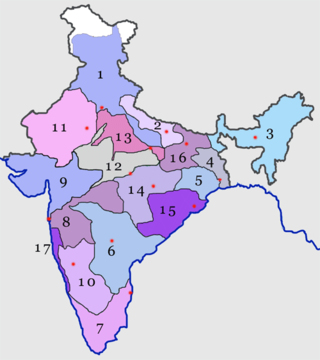
The North Western Railway is one of 19 railway zones in India. It is headquartered at Jaipur, Rajasthan and has 59,075+ employees, 658+ stations and a route length of more than 5,761 kilometres (3,580 mi) across the states of Rajasthan, Gujarat, Punjab and Haryana. NWR operates international rail service Thar Express from Jodhpur to Karachi. This zone is the key enabler of the Delhi–Mumbai Industrial Corridor Project by virtue of running railways 1,500 km long Western Dedicated Freight Corridor.

The Northern Railway (NR) is one of the 17 Railway zones of India and the northernmost zone of the Indian Railways. It is headquartered at Baroda House in New Delhi.
Sadulpur ,(previously known as Rajgarh) is a city, municipality, tehsil and Legislative Assembly seat in Churu district of northern part of Rajasthan state in India. It was the territory of the gaur dynasty later after defeated in war with shekhawat rajputs ,It lies in Shekhawati region at an elevation of 239 m (784 ft). To distinguish Rajgarh from several other places with same name, Sadulpur has become a synonym of Rajgarh town's name in recent times.

Haryana, formed on 1 November 1966, is a state in North India. For the administrative purpose, Haryana is divided into 6 revenue divisions which are further divided into 22 districts. For Law and Order maintenance, it is divided into 5 Police Ranges and 4 Police Commissionerates.

Rewari Junction railway station is a major railway station of the Indian Railways serving the city of Rewari in the Indian state of Haryana. It is in the Jaipur Division of the North Western Railway zone and lies on the Delhi–Ajmer–Ahmedabad route. Six railway lines branch out from this railway station.

The Delhi–Fazilka line is a railway line connecting Delhi and Fazilka the latter in the Indian state of Punjab. There is a link to Firozpur Cantonment. The line is under the administrative jurisdiction of Northern Railway. This line was a part of the historic Delhi–Karachi line.

The Jaipur–Ahmedabad line connects Jaipur, the capital of Rajasthan to Ahmedabad, the largest city of Gujarat in India. It is present on Ahmedabad–Delhi main line. Swarna Jayanti Rajdhani Express is the fastest train in this route.

The Jodhpur–Bathinda line connects Jodhpur, in the Indian state of Rajasthan to Bathinda in the Punjab, via Dabwali Railway in Haryana. During the British Raj, Bathinda was on the Delhi–Karachi line and after independence and partition of India in 1947, it is on the Delhi–Fazilka line. This line operates under the jurisdiction of North Western Railway.
Bikaner railway station is located in Bikaner district in the Indian state of Rajasthan. It serves Bikaner. Bikaner is headquarters of Bikaner railway division.
Bathinda Railway Station is located in Bathinda in the Indian state of Punjab.

The Bathinda–Rewari line is a railway line connecting Bathinda in the Indian state of the Punjab and Rewari in Haryana. There are links to Sadulpur and Rohtak also. The line is under the administrative jurisdiction of Northern Railway and North Western Railway.
Bhiwani Railway Station is located in Bhiwani district in the Indian state of Haryana. It serves Bhiwani.
Chittaurgarh Junction railway station is one of the major railway junctions in Southern Rajasthan, India. The railway station of Chittorgarh is located on a broad-gauge line and falls under the administrative control of Western Railway Zone of Indian Railways and consists of seven main railway platforms.

Jaipur railway division is one of the four railway divisions under North Western Railway zone of Indian Railways. This railway division was formed on 5 November 1951. Its headquarters are located at Jaipur in the state of Rajasthan of India.
Hisar Junction railway station is an A-category railway station, under the Bikaner railway division of North Western Railway zone of Indian Railways, located at Hisar city in Hisar district of Haryana state of India. The station consists of 6 platforms, with 6 broad-gauge mostly electrified tracks of Bathinda–Rewari line and Jakhal–Hisar–Sadalpur line, going in 4 directions at an average speed of 120 km/h. Hisar is one of the 400 stations to be redeveloped with international and private partners for modernization on international standards and optimizing the commercial opportunities.
Phulera Junction railway station is a main railway station in Jaipur district, Rajasthan. Its code is FL. It serves Phulera town. The station consists of 5 platforms. The station lies on Jaipur–Ahmedabad main line which connects Jaipur to Ajmer and Ahmedabad as well as Merta Road–Rewari line which connects Jodhpur to Jaipur and Delhi. 111 trains pass through the station and 5 of the originates form the station. It also houses the YDM-4 Locomotives that serve the Mavli-Marwar Metre Gauge Line

Rail transport in the state of Haryana, India, is conducted by five rail divisions in three zones: the North Western Railway zone, Northern Railway zone, and North Central Railway zone. The Diamond Quadrilateral high-speed rail network, Eastern Dedicated Freight Corridor, and Western Dedicated Freight Corridor pass through Haryana.
The Bikaner–Rewari line or Rewari–Bikaner line is a railway route on the North Western Railway zone of Indian Railways. This route plays an important role in rail transportation of Bikaner division and Jaipur division of Rajasthan state and Gurugram division of Haryana state.
The Merta Road–Rewari line or Merta Road–Phulera–Rewari line is a railway route on the North Western Railway zone of Indian Railways. This route plays an important role in rail transportation of Bikaner division, Ajmer division and Jaipur division of Rajasthan state and Gurugram division of Haryana state.
The Shri Ganganagar–Sadulpur line or Sri Ganganagar–Hanumangarh–Ellenabad–Sadulpur line is a railway route on the North Western Railway zone of Indian Railways. This route plays an important role in rail transportation of Bikaner division of Rajasthan state and Ellenabad portion of Sirsa district of Haryana.






